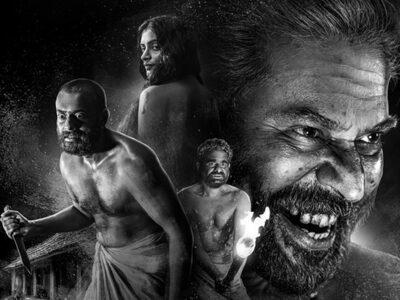Mangalavaaram: A Mixed Bag of Intrigue, Humor, and Flaws
Aditya Taksh dissects ‘Mangalavaaram’ in this insightful review, unraveling the film’s intricacies, dark humor, and unexpected twists, while spotlighting Ajay Bhupathi’s directorial finesse.
Rating: 2
A Dual Suicide and a Touch of Cheeky Comedy
Mangalavaaram begins with a dual suicide of a father-son duo. The melancholy mood turns into one of cheeky comedy when Ajay Ghosh’s Kasi and Laxman Meesala’s visually-challenged character read slanderous gossip on a wall in the village. A young man and woman engaged in an illicit relationship have been exposed. Dark humour takes over when the duo is found dead.
A Police Officer with More Talk than Action
Nandita Swetha plays Maya, who behaves like a junior Vijayashanthi-type cop minus the bite of Vijayashanthi. She wants everyone in the village to believe that she is unforgiving. In reality, she does nothing substantial. She seems to talk and do nothing, occasionally making obvious or redundant observations at sites of crime.
One-Liners and Forced Humor: A Missed Opportunity for World-Building
That’s the problem with a lot of characterizations in this film. There are one-liners that add nothing to the plot. The dialogues are not clever and rarely stem from the world. The generic dialogue and forced humour especially the track involving Ajay Ghosh) rob the film of any world-building it would otherwise have done.
An Uneven First Half: Lack of Mood Creation and Over-the-Top Characters
Director Ajay Bhupathi of ‘RX 100’ fame achieves too little in the first half, as his screenplay achieves little by way of mood creation. Chaitanya Krishna as a Zamindar named Prakasam Babu rages against his dead dad and threatens a priest. A male character passes cheap comments on the ‘figures’ of women, then there are men who seem to have no job other than ogling at women.
Tone-Deaf Characters and Overreactions: A Missed Opportunity
Ravindra Vijay’s RMP Doctor is not a well-developed character either. Some of his lines are a dead giveaway. Everyone in the village is tone-deaf. Characters keep over-reacting, especially in the first half.
A Redeeming Second Half: Well-Written Twists and Plot Points
The director’s itch for shock value comes to the fore in the last 30 minutes. To be fair to him, most of the twists and plot points in the second half are well-written. It is this segment that truly redeems the movie.
Miscasting and Immature Treatment of Nymphomania
Payal Rajput was miscast. A newcomer with no image should have played Shailu, a person affected by sexual disorder. The director’s treatment of Nymphomania is immature to an extent. It is also bizarre that the makers have talked about the heroine’s disorder post-release promotions when it is an element that should have been kept under wraps to maintain surprise factor.
Exceptional Visual Quality and Music: A Saving Grace
Dasaradhi Sivendra’s cinematography is thorough. Mudhra Media Works and A Creative Works spending Rs 20 crore on the movie’s budget resulted in top-notch visual quality. The post-production work shows. Even some acclaimed movies in recent times (like Masooda) did have off-putting night shots. In contrast, Mangalavaaram is superior in terms of the quality of visuals on display. Ajaneesh B Loknath’s background score is praise-worthy. The ‘Kantara’ and ‘Virupaksha’ composer doesn’t let go of any opportunity. MR Rajakrishnan’s sound design and other aspects add heft to the technical quality.
In conclusion, Mangalavaaram is a film with a disjointed narrative that struggles to find its footing in the first half. However, the redeeming second half, with its well-written twists and plot points, partially salvages the film. The exceptional visual quality and music further elevate the production, while the miscasting and immature treatment of Nymphomania remain notable shortcomings.
















